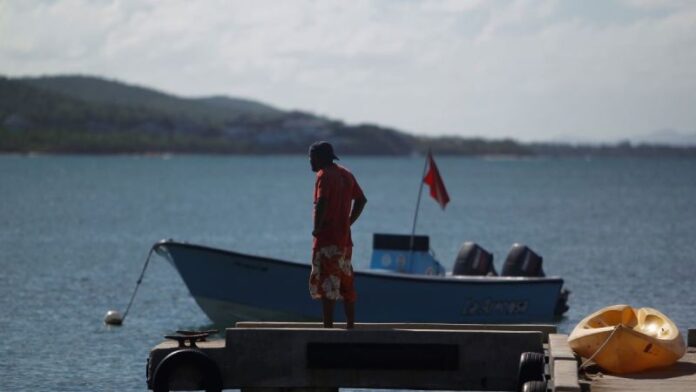(CNN Spanish) – As in other parts of the world, the coasts of Puerto Rico have begun to experience situations related to rising sea levels. Some scholars who are experts on the subject have raised their voices of alarm.
“The effects are already happening and have been happening for a long time, years. One thing that is not talked about much, for example, is that as the sea level rises, the water table inland also rises and then all those lands that are low are going to be permanently flooded,” explains Aurelio Mercado, professor at the Department of Physical Oceanography of the Mayagüez Campus of the University of Puerto Rico.
“The water line is moving inland, but we are talking about in two years, three meters, four meters. And this means that now events of lesser magnitude, perhaps such as tropical waves or simply surges of cold fronts that are not so intense or not so strong, are causing the same damage that a category three hurricane could be doing,” says Maritza Barreto, director of the Institute. of Coastal Research and Planning at the Río Piedras campus of the University of Puerto Rico.
An analysis published in June by the Union of Conscious Scientists (UCS) titled “Looming Deadlines for Coastal Resilience” revealed that “by 2050 nearly 1,100 infrastructure facilities located along the coast of the United States “The United States would flood on average 12 times a year.”
Puerto Rico was included as one of the territories where 325 essential infrastructure facilities would be affected and predicts an average rise in sea level of 97.5 cm on average globally by 2100. The infrastructures at greatest risk include residential areas, and places with industrial pollution.
“If we also look at infrastructure, right, according to the distribution along the strip of the coast plus the presence of coastal erosion, which also aggravates the situation, then we are talking about a high amount of critical infrastructure, populations, community settlements. , as well as services. We could have impacts on services and economic activities,” says Barreto.
But it’s not just the effects in the local area that scholars are monitoring. They propose that the actions that have occurred in other parts of the planet are already being felt in Puerto Rico. They even talk about when they expect the situation on the island to worsen further.
“I dare say that around 2050 things are going to get interesting, because in 2010 and 2011 an acceleration was observed that will continue its course and the roadblock is how the glaciers will behave.” in Antarctica,” Mercado said.
“And it is very interesting that speaking of the events in the Pacific, speaking of the melting of ice, it is important to see that in many of the projections that are being made about sea level rise in the case of Puerto Rico, right now it is happening at a rate An increase of one foot compared to today’s condition by 2050 is an extremely conservative figure,” says Barreto.
In mid-September, a group of scientists studying that region discovered that the Thwaites Glacier in Antarctica is melting at an accelerated rate. According to the World Meteorological Organization’s climate report, sea level in the Pacific Ocean has risen almost twice as much as the global average over the past 30 years.
The Puerto Rican Planning Society has detailed the manifestations of climate change on the island. These are rise in sea level and high temperatures, coastal erosion, frequency and intensity of droughts and rains, increase in forest fires, intensity of hurricanes, storms and episodes of dust clouds from the Sahara Desert.
Meanwhile, the Legislative Assembly of Puerto Rico has before it for approval the so-called Climate Change Mitigation, Adaptation and Resilience Plan of Puerto Rico. The document would establish public policy on this issue and create the Committee of Experts and Advisors on Climate Change (CEACC), made up of representatives from different sectors who will identify adaptation measures in areas such as energy, water, coastal zone, health, agriculture, waste. solids, transportation, tourism, reforestation, infrastructure and tourism.
“And in that plan there are approximately fourteen strategies to confront the problem of rising sea levels. It also talks about the importance of maintaining geodata that is information about the infrastructure and about all the services that are provided to see how, through modeling the rise in sea level, we can see which infrastructures are affected and be able to protect them. adapt them from the most vulnerable hours,” said Barreto, who is also a committee member.
The current president of the Senate of Puerto Rico, José Luis Dalmau, reported that the legislature has until 2025 to approve the plan.
Both Mercado and Barreto have stressed the importance of making the document a reality. As an example, they mentioned that the coastal areas of the municipalities of Loíza, Luquillo, Rincón, Hatillo and Peñuelas are some of the most vulnerable and where the sea has already begun to change part of the geography. “And then what that does is that when a hurricane comes with its storm surge it exacerbates the damage done by the hurricane because the base sea level is already high,” Mercado said.
Barreto admitted that he has reservations about how authorities will handle the situation. “The future is not very, really positive, in the sense that I understand that the response to sea level rise has been slower than the sea level effect itself, which was originally thought to be a very slow and which really is not.”

